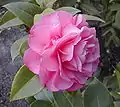Camellia × williamsii
Camellia × williamsii is a cultivar group of hybrid evergreen shrubs that are derived from a crossing of Camellia saluenensis with Camellia japonica.[1] It was originally bred in 1923 at Caerhays Castle in Cornwall by John Charles Williams.[2]
| Camellia × williamsii | |
|---|---|
 | |
| Genus | Camellia |
| Species | Camellia × williamsii |
| Cultivar group | × williamsii |
| Origin | Originally bred in Cornwall by J.C. Williams.[1] |
Cultivars
Williamsii cross camellias are hardier than most, and will grow outside anywhere in the UK. Some varieties are known to perform better in colder climates than in warmer ones. 'E.G. Waterhouse', for instance, grows better in Melbourne than it does in Sydney, where it was bred. Hybrid vigour has made the group unusually floriferous, with such varieties as 'St Ewe' flowering for four to five months (December to April in the UK).[2] Some crosses show the elliptical and pointed leaves of C. saluenensis,[3] others the more rounded leaves of C. japonica. Some crosses introduced colours new to camellias: 'Donation' is said to be Tyrian rose, 'Lady Gowrie' fuchsine pink.[4] Nearly all crosses have flowers with translucent petals.
More than 100 named cultivars have been bred.[1]
AGM cultivars
The following cultivars have gained the Royal Horticultural Society's Award of Garden Merit.
| Name | Flower colour | Height (m) | Spread (m) | Ref. |
|---|---|---|---|---|
| Anticipation | rose-pink | 4.0 | 2.5 | [5] |
| Bowen Bryant | pink | 4.0 | 4.0 | [6] |
| Brigadoon | pink | 4.0 | 2.5 | [7] |
| China Clay | white | 2.5 | 2.5 | [8] |
| Clarrie Fawcett | pale pink | 4.0 | 4.0 | [9] |
| Daintiness | salmon pink | 4.0 | 2.5 | [10] |
| Debbie | rose pink | 4.0 | 4.0 | [11] |
| Donation | pink | 8.0 | 8.0 | [12] |
| E.T.R. Carlyon | white | 4.0 | 2.5 | [13] |
| Elegant Beauty | rose pink | 4.0 | 2.5 | [14] |
| Elsie Jury | rose pink | 4.0 | 2.5 | [15] |
| George Blandford | pink | 4.0 | 4.0 | [16] |
| Glenn's Orbit | deep pink | 4.0 | 4.0 | [17] |
| J.C. Williams | pale pink | 4.0 | 4.0 | [18] |
| Joan Trehane | pink (light) | 4.0 | 4.0 | [19] |
| Julia Hamiter | pink/white | 4.0 | 4.0 | [20] |
| Jury's Yellow | white/yellow | 4.0 | 4.0 | [21] |
| Les Jury | crimson | 2.5 | 1.5 | [22] |
| Muskoka | pink/red | 4.0 | 4.0 | [23] |
| Ruby Wedding | red | 2.5 | 2.5 | [24] |
| Saint Ewe | rose pink | 4-0 | 4.0 | [25] |
| Señorita | pink | 2.5 | 2.5 | [26] |
| Water Lily | rose pink | 4.0 | 2.5 | [27] |
Gallery
 'Brigadoon'
'Brigadoon' 'Citation'
'Citation' 'Debbie'
'Debbie' 'Daintiness'
'Daintiness' 'La Sonnambula'
'La Sonnambula' 'Taylor's Perfection'
'Taylor's Perfection' 'Margaret Waterhouse'
'Margaret Waterhouse'
Cultivation
C. × williamsii is an excellent companion to other acid-loving woodland plants such as rhododendron. It grows best in acid soil, ph5.5-6.5, in a sunny or partially shaded, sheltered position. In areas with frost and cold winds, it should be positioned facing away from the morning sun, as the flower buds are easily damaged.[28]
References
- Rowell, Raymond J. (1980). Ornamental Flowering Shrubs in Australia. Australia: AH & AW Reed Pty Ltd. ISBN 978-0589501778.
- "Camellias". Caerhays Estate. Retrieved 21 August 2017.
- Mitchell, Bob. "Plant of the month". St Andrews Botanic Garden. Retrieved 22 August 2017.
- Sparnon, Norman; Waterhouse, Eben Gowrie (1968). The Magic of Camellias; Creative Ideas for Japanese Flower Arrangement. Sydney: Ure Smith. Pages 36, 40.
- "Camellia × williamsii 'Anticipation'". Royal Horticultural Society. Retrieved 22 July 2013.
- "Camellia × williamsii 'Bowen Bryant'". Royal Horticultural Society. Retrieved 12 February 2020.
- "Camellia × williamsii 'Brigadoon'". Royal Horticultural Society. Retrieved 22 July 2013.
- "Camellia × williamsii 'China Clay'". Royal Horticultural Society. Retrieved 12 February 2020.
- "Camellia × williamsii 'Clarrie Fawcett'". RHS. Retrieved 12 February 2020.
- "Camellia × williamsii 'Daintiness'". Royal Horticultural Society. Retrieved 22 July 2013.
- "Camellia × williamsii 'Debbie'". Royal Horticultural Society. Retrieved 12 February 2020.
- "Camellia × williamsii 'Donation'". Royal Horticultural Society. Retrieved 22 July 2013.
- "Camellia × williamsii 'E.T.R. Carlyon'". Royal Horticultural Society. Retrieved 12 February 2020.
- "Camellia × williamsii 'Elegant Beauty'". Royal Horticultural Society. Retrieved 22 July 2013.
- "Camellia × williamsii 'Elsie Jury'". Royal Horticultural Society. Retrieved 12 February 2020.
- "Camellia × williamsii 'George Blandford'". Royal Horticultural Society. Retrieved 11 February 2020.
- "Camellia × williamsii 'Glenn's Orbit'". Royal Horticultural Society. Retrieved 22 July 2013.
- "Camellia × williamsii 'J.C. Williams'". Royal Horticultural Society. Retrieved 11 February 2020.
- "Camellia × williamsii 'Joan Trehane'". RHS. Retrieved 12 February 2020.
- "Camellia × williamsii 'Julia Hamiter'". www.rhs.org. Royal Horticultural Society. Retrieved 11 February 2020.
- "Camellia × williamsii 'Jury's Yellow'". Royal Horticultural Society. Retrieved 22 July 2013.
- "Camellia × williamsii 'Les Jury'". Royal Horticultural Society. Retrieved 1 February 2020.
- "Camellia × williamsii 'Muskoka'". Royal Horticultural Society. Retrieved 12 February 2020.
- . RHS https://www.rhs.org.uk/Plants/57525/Camellia-x-williamsii-Ruby-Wedding-(d)/Details. Retrieved 18 February 2019. Missing or empty
|title=(help) - "Camellia × williamsii 'Saint Ewe'". Royal Horticultural Society. Retrieved 22 July 2013.
- "Camellia × williamsii 'Senorita'". RHS. Retrieved 12 February 2020.
- "Camellia × williamsii 'Water Lily'". Royal Horticultural Society. Retrieved 22 July 2013.
- RHS A-Z encyclopedia of garden plants. United Kingdom: Dorling Kindersley. 2008. p. 1136. ISBN 978-1405332965.
| Wikispecies has information related to Camellia × williamsii. |
| Wikimedia Commons has media related to Camellia × williamsii. |